Symphyotrichum lateriflorum
A small-flowered aster with a ragged look
Symphyotrichum lateriflorum calico aster
Add to MyPlants View Locations
This species is one of a group of small-flowered native asters that are often difficult to distinguish. This variable species is common in eastern and central North America and is abundant in Pennsylvania. The calico aster has yellow central disk florets that turn purple-red as the flower matures. Sometimes there are yellow and purple disk florets on the plant at the same time. This gives it a multi-colored look that is responsible for the plant’s common name. The ray florets number between 9 and 15 and are white. The composite flowers are small—about 1/3 inch in diameter and are generally found in elongated clusters along one side of long divergent branches. The bracts of the flowers have greenish midribs.
The basal leaves of calico aster are stalked but often drop off as the plant grows. The smaller upper leaves are 2-6 inches long, lance-shaped to elliptical. The leaves have smooth margins except for a few coarse teeth at the tips of the larger leaves. Stems can be purple or green. The plant grows from one to five feet tall and is found in moist fields and thickets, usually in partial sun. The species often forms colonies in favorable areas, spreading by underground rhizomes. The flowers have no scent but nectar attracts a variety of insect pollinators. The seeds have tufts of hair that allow for wind distribution.
The calico aster may sometimes hybridize with related species, making identification more difficult. It is also known by the names starved aster, one-sided aster, goblet aster, or lance-leaf aster. The calico aster is most often confused with the small white aster (S. vimineus), The latter has fewer teeth on its smaller leaves and small leaflets in the leaf axils. It is also supposed to have overall lighter-colored disk florets. Some taxonomists indicate that the two should belong to the same species as S. lateriflorum. Other asters with small white ray florets are also sometimes considered varieties of S. lateriflorum. It would probably take a systematic DNA study to determine species boundaries among these physical types.
Habitat & Range
Common in old fields, rocky woods, roadsides, and waste ground.
Present throughout, except northernmost counties.
| EMP: | FACW |
|---|---|
| NCNE: | FAC |
Phenology
Flowers late August through October.
Characteristics
Flowers branching clusters of flower heads at the top of the stem and arising from upper leaf axils. Branches often spread widely with all the flowers on one side of the branch. Flower rays white or sometimes pinkish, disk corollas pink soon becoming reddish purple.
Leaves thin, lance-elliptic, tapering at both ends and mostly without pedicels. Basal leaves are broader and more variable in shape, with winged sheathing stalks. Basal and lower stem leaves wither away by flowering time. Leaves become more lance-linear as they climb up the stem. Edges are entire or crenate.
Stems single or multiple from a branched rootstock or short rhizome, erect to ascending or can be arching; sparsely to densely pubescent covered with soft, white hairs.
Fruits dry seed with tuft of white hairs, gets carried off by the wind.
Identification Tips
The flower heads are often on one side of the branch.
Plant Codes
S-rank: S5 (Secure)
G-rank: G5 (Secure)
Symphyotrichum lateriflorum calico aster
Synonyms: Aster lateriflorusAdd to MyPlants View Locations
Plant Summary
Common Names
Symphyotrichum

















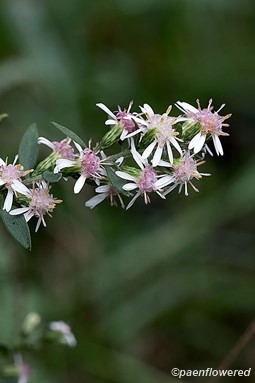
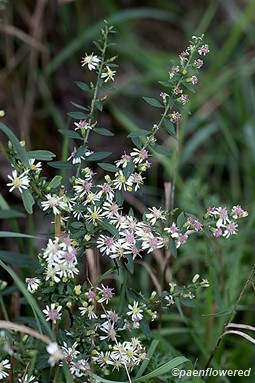
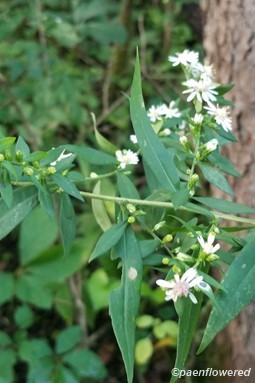
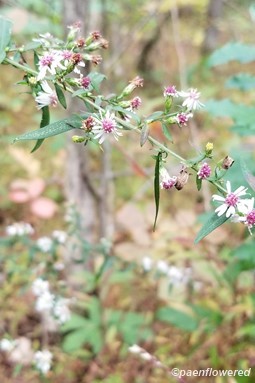
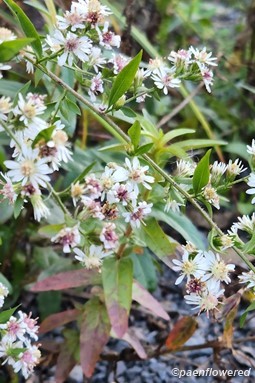
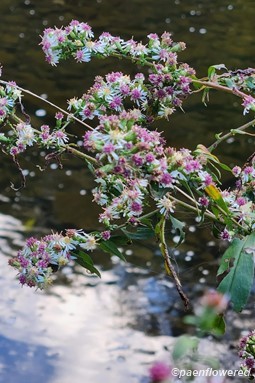


Comments
Have you spotted this plant in your area? We'd love to hear about your experience! Share your comments or questions about the plant below. Comments are moderated before posting.